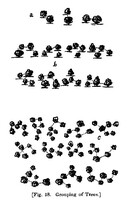The chief care, then, which is necessary in the formation of groups, is, not to place them in any regular or artificial manner,-as one at each corner of a triangle, square, octagon, or other many-sided figure; but so to dispose them, as that the whole may exhibit the variety, connexion, and intricacy seen in nature. "The greatest beauty of a group of trees," says Loudon, "as far as respects their stems, is in the varied direction these take as they grow into trees; but as that is, for all practical purposes, beyond the influence of art, all we can do, is to vary as much as possible the ground plan of groups, or the relative positions which the stems have to each other where they spring from the earth. This is considerable, even where a very few trees are used, of which any person may convince himself by placing a few dots on paper. Thus two trees (fig. 18), or a tree and shrub, which is the smallest group (a), may be placed in three different positions with reference to a spectator in a fixed point; if he moves round them, they will first vary in form separately, and next unite in one or two groups, according to the position of the spectator. In like manner, three trees may be placed in four different positions; four trees may be placed in eight different positions (b); five trees may be grouped in ten different ways, as to ground plan; six may be placed in twelve different ways (c), and so on." (JC Loudon Encyclopaedia of Gardening.)

